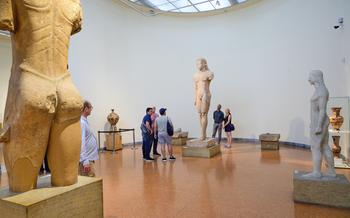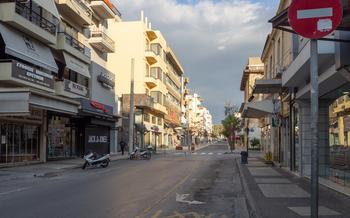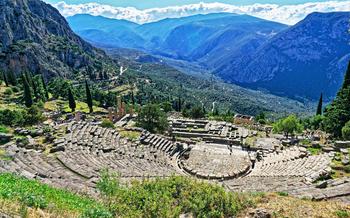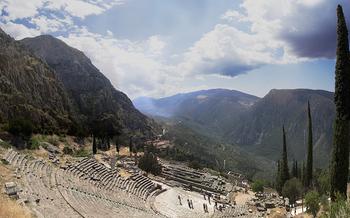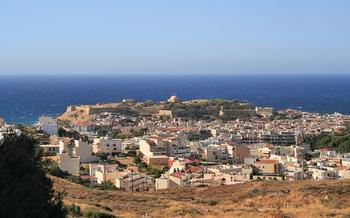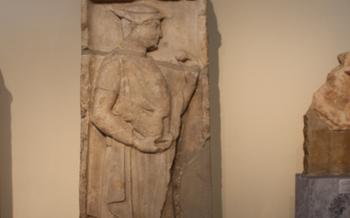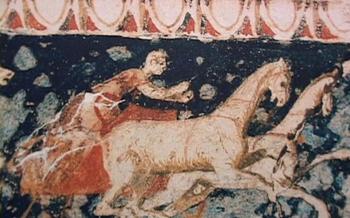
Kolindros Archaeological Museum
- The Antiquity of Kolindros. Archaeological Museum:
- Exploring the Museum's Exhibits
- Unique Artifacts and Their Stories
- Historical Context and Significance
- Interactive Exhibits and Activities:
- Temporary Exhibitions and Events:
- Guided Tours and Educational Programs:
- Accessibility and Facilities
- Community Engagement and Outreach
- Digital Resources and Online Presence
- Research and Archaeological Discoveries
- Preservation and Conservation Efforts
- Local Legends and Folklore
- Collaborative Projects and Partnerships
- Insider Tip: Enhance Your Visit to the Kolindros Archaeological Museum
The Antiquity of Kolindros. Archaeological Museum:
Kolindros, a picturesque town on the Pierian coast of Greece, boasts a rich history dating back to ancient times. Its significance as a regional center is evidenced by the impressive collection of artifacts housed in the Kolindros Archaeological Museum. Established in the early 20th century, the museum underwent a major renovation and expansion in the 1980s, resulting in the modern facility that visitors can explore today.
The museum's collection primarily focuses on the archaeological treasures unearthed from excavations conducted in and around Kolindros. These artifacts provide a glimpse into the daily lives, customs, and artistic expressions of the region's ancient inhabitants. Through its exhibits, the museum plays a crucial role in preserving and showcasing the cultural heritage of this historic town, providing visitors with a deeper understanding of the area's past.
Practical Information:
- Visiting Hours: Tuesday - Sunday: 8:00 AM - 3:00 PM
- Admission Fees: Regular: €5, Reduced: €3, Children under 12: Free
- Accessibility: Wheelchair ramps, elevators, and accessible restrooms are available.
Exploring the Museum's Exhibits
The Kolindros Archaeological Museum houses a diverse collection of artifacts that provide a glimpse into the region's rich history and cultural heritage. Visitors can embark on a journey through time as they explore the museum's exhibits, which showcase a wide range of archaeological findings from prehistoric settlements to the Roman era.
Among the notable exhibits are impressive pottery collections that showcase the artistry and craftsmanship of ancient artisans. Visitors can admire intricately painted vases, amphorae, and other ceramic vessels that were used for various purposes in everyday life. The museum also features a remarkable collection of sculptures, including marble statues, bronze statuettes, and terracotta figurines that depict deities, heroes, and mythological creatures.
Tools and implements used by the ancient inhabitants of the region offer insights into their daily lives and occupations. From simple stone tools to more sophisticated metalworking equipment, these artifacts provide a glimpse into the technological advancements and economic activities of the past. Visitors can also examine jewelry, coins, and other personal items that shed light on the fashion, customs, and social interactions of the ancient people.
Interactive displays and educational resources enhance the visitor experience, making learning about history more engaging and informative. Touchscreens and multimedia presentations provide detailed information about the artifacts and their historical context. Visitors can also participate in hands-on activities, such as pottery-making workshops or educational games, that allow them to connect with the past in a tangible way.
Unique Artifacts and Their Stories
Among the many captivating artifacts housed within the Kolindros Archaeological Museum, several stand out for their rarity, beauty, or historical significance. One such artifact is an exquisitely crafted gold necklace adorned with intricate filigree work and sparkling gemstones. Discovered in a nearby ancient tomb, the necklace is believed to have been worn by a wealthy and influential individual during the Hellenistic period. Its intricate design and the use of precious materials offer a glimpse into the opulence and craftsmanship of that era.
Another remarkable artifact is a well-preserved bronze statue depicting a young athlete in a dynamic pose. The statue showcases the exceptional skill and attention to detail of ancient Greek sculptors. Its lifelike features and musculature convey a sense of movement and energy, capturing the essence of athleticism and the pursuit of physical perfection that was central to ancient Greek culture.
Of particular interest is a collection of ceramic vessels that provide insights into the daily lives and customs of the region's inhabitants. These vessels, which range from simple utilitarian pots to elaborately decorated vases, showcase a variety of shapes, sizes, and designs. They offer clues about the region's agricultural practices, culinary traditions, and trade connections with other parts of the ancient world.
These unique artifacts, with their captivating stories, offer a tangible connection to the past and provide a glimpse into the rich cultural heritage of the region. They serve as reminders of the creativity, skill, and artistry of the ancient inhabitants of Kolindros and the surrounding area.
Historical Context and Significance
The Kolindros Archaeological Museum houses a collection of artifacts that span a wide range of historical periods, from prehistoric times to the Roman era. These artifacts provide valuable insights into the political, social, and economic aspects of ancient life in the region.
The prehistoric period is represented by tools, pottery, and other objects that shed light on the daily lives and customs of the earliest inhabitants of the area. The Bronze Age collection includes impressive bronze weapons, tools, and jewelry, showcasing the region's participation in the wider cultural developments of the period.
The Classical period is represented by an array of pottery, sculptures, and coins, reflecting the influence of the major city-states of ancient Greece. These artifacts provide glimpses into the region's participation in trade and cultural exchange, as well as its interactions with the broader Greek world.
The Hellenistic and Roman periods are represented by a rich collection of pottery, sculptures, and other objects that attest to the region's continued prosperity and cultural vitality. These artifacts showcase the influence of Hellenistic and Roman artistic styles and techniques, as well as the region's role in the wider Mediterranean world.
By exploring these artifacts and their historical context, visitors to the Kolindros Archaeological Museum gain a deeper understanding of the rich and diverse past of the region, its connections to the broader Greek world, and its contributions to ancient civilization.
Interactive Exhibits and Activities:
The Kolindros Archaeological Museum offers a range of interactive exhibits and activities to enhance the visitor experience and make learning about history more engaging. These interactive elements bring the past to life and allow visitors to connect with the artifacts on a deeper level.
One popular interactive display is the "Virtual Reality Time Machine." Using virtual reality technology, visitors can step back in time and explore ancient Kolindros and its surroundings. This immersive experience transports visitors to the heart of the ancient city, where they can interact with virtual characters, witness historical events, and gain a firsthand perspective of daily life in the past.
Another interactive exhibit, the "Touch and Feel Table," allows visitors to handle replicas of ancient artifacts and learn about their functions and significance. This hands-on experience is particularly popular with children, who can explore the textures and shapes of pottery, tools, and other objects from the museum's collection.
The museum also offers educational programs and workshops tailored to specific audiences, such as school groups and families. These programs are designed to make history fun and engaging for younger visitors. Through storytelling, crafts, and interactive activities, children can learn about ancient Greece, its mythology, and the importance of preserving cultural heritage.
Temporary Exhibitions and Events:
The Kolindros Archaeological Museum keeps its offerings fresh and dynamic by hosting temporary exhibitions and special events throughout the year. These exhibitions often explore specific themes or collaborate with other institutions to bring unique perspectives and artifacts to the museum.
Temporary exhibitions may focus on a particular historical period, a specific type of artifact, or the work of a renowned archaeologist. They provide an opportunity for the museum to delve deeper into specific topics and showcase new discoveries or research findings.
Special events, such as lectures, workshops, or cultural performances, are organized to engage visitors and foster a deeper appreciation for the region's history and culture. These events often feature experts, scholars, or local artists who share their knowledge and insights with the audience.
By hosting temporary exhibitions and events, the Kolindros Archaeological Museum offers visitors a diverse and evolving experience. It encourages repeat visits and keeps the museum relevant and exciting for both locals and tourists alike. To stay updated on upcoming exhibitions and events, visitors can check the museum's website or social media channels.
Guided Tours and Educational Programs:
The Kolindros Archaeological Museum offers a range of guided tours and educational programs to enhance the visitor experience and provide deeper insights into the exhibits. Guided tours are conducted by knowledgeable museum guides who share their expertise and answer questions. Visitors can choose from general tours that provide an overview of the museum's collection to more specialized tours focused on specific periods or themes. The museum also offers educational programs and workshops tailored to different audiences, including school groups, families, and adults. These programs are designed to engage participants with hands-on activities, interactive displays, and storytelling, making learning about history and archaeology both enjoyable and informative. Booking a guided tour or registering for an educational program is highly recommended to make the most of your visit to the Kolindros Archaeological Museum.
Accessibility and Facilities
The Kolindros Archaeological Museum is committed to providing an accessible and inclusive experience for all visitors. The museum is wheelchair accessible, with ramps and elevators throughout the building. Accessible restrooms are also available.
For visitors with disabilities, the museum offers a variety of services and accommodations. Visitors can request a portable ramp for easy access to the museum entrance. Wheelchairs are also available for loan on a first-come, first-served basis.
The museum also has a number of facilities to make the visit more enjoyable for all visitors. A gift shop is located in the lobby, where visitors can purchase souvenirs and books related to the museum's collection. A café is also available, where visitors can enjoy a light snack or beverage.
The museum staff is always happy to assist visitors with any questions or requests. Visitors with specific needs are encouraged to contact the museum in advance to make arrangements.
Community Engagement and Outreach
The Kolindros Archaeological Museum actively engages with the local community to foster a sense of ownership and connection with its rich cultural heritage. Through various outreach programs, workshops, and events, the museum aims to promote archaeological awareness and education among the residents of Katerini and the surrounding region. Collaborations with local schools, organizations, and institutions play a crucial role in these initiatives. The museum believes that by involving the community in its activities, it can create a lasting impact and ensure that the legacy of the region's past continues to thrive. Success stories abound, such as the establishment of a youth archaeological club that brings together young enthusiasts who participate in excavations and learn about the importance of preserving their heritage. The museum's commitment to community engagement extends beyond its walls, creating a vibrant and inclusive space where the past and present converge.
Digital Resources and Online Presence
The Kolindros Archaeological Museum actively engages with a global audience through its comprehensive website and social media channels. The museum's website offers virtual tours of its exhibits, allowing visitors worldwide to explore the collection from the comfort of their own homes. Additionally, the museum's website features educational materials, research publications, and detailed information about its artifacts and ongoing projects. Through social media platforms, the museum shares captivating images, videos, and updates on recent discoveries and events, fostering a vibrant online community of history enthusiasts. These digital resources provide invaluable access to the museum's treasures and contribute to the preservation and dissemination of archaeological knowledge beyond the physical boundaries of the museum.
Research and Archaeological Discoveries
The Kolindros Archaeological Museum is not merely a repository of ancient artifacts; it is also an active participant in ongoing archaeological research and excavations in the region. The museum collaborates closely with archaeologists and scholars to advance our understanding of the area's rich history.
Recent significant discoveries, such as the uncovering of a well-preserved ancient settlement or the discovery of rare artifacts, have shed new light on the region's past. These findings are meticulously documented, analyzed, and integrated into the museum's collection, enriching its historical narrative.
The museum's role in archaeological research extends beyond excavations. It provides a platform for scholars to present their findings, host conferences, and engage in discussions that contribute to the advancement of knowledge in the field.
By actively participating in research and excavations, the Kolindros Archaeological Museum fulfills its mission to preserve and showcase the region's cultural heritage while contributing to our ever-evolving understanding of the ancient world.
Preservation and Conservation Efforts
The Kolindros Archaeological Museum is dedicated to preserving and conserving its artifacts to ensure their longevity and accessibility for future generations. The museum employs a team of skilled conservators who use state-of-the-art techniques and methods to restore, conserve, and display the artifacts in their best condition.
Artifacts are carefully examined and assessed upon arrival at the museum to determine the appropriate conservation measures. Conservators may employ various techniques, such as cleaning, stabilization, and repair, to address damage caused by age, environmental factors, or improper handling.
The museum also maintains a controlled environment within its exhibition spaces, ensuring optimal temperature, humidity, and lighting conditions to minimize the deterioration of artifacts. Special display cases and mounts are used to protect the artifacts from dust, moisture, and harmful UV rays.
The conservation efforts at the Kolindros Archaeological Museum are crucial in preserving the region's cultural heritage and ensuring that future generations can continue to learn about and appreciate the remarkable artifacts from the past.
Local Legends and Folklore
The Kolindros Archaeological Museum is not just a repository of ancient artifacts; it is also a treasure trove of local legends and folklore. These stories, passed down through generations, add a touch of magic and intrigue to the museum's exhibits. One captivating legend is that of the "Golden Fleece," said to have been hidden in the nearby Pierian Mountains. According to the myth, Jason and the Argonauts embarked on a daring quest to retrieve this legendary treasure.
Another intriguing tale is that of the "Cyclops of Pieria." Local folklore speaks of a one-eyed giant who once roamed the region, leaving behind massive boulders as evidence of his presence. These colossal rocks, scattered throughout the countryside, are known as "Cyclopean Walls" and are believed to be remnants of his colossal constructions.
These legends and stories are deeply intertwined with the region's history and culture, adding a layer of enchantment to the artifacts displayed in the museum. They remind us that the past is not merely a collection of objects but a tapestry of beliefs, traditions, and narratives that continue to shape our understanding of the world.
Collaborative Projects and Partnerships
The Kolindros Archaeological Museum actively collaborates with other institutions and organizations to enhance its offerings, promote cultural exchange, and advance archaeological knowledge. One notable partnership is with the University of Thessaly's Department of Archaeology. Together, they have conducted joint research projects, organized workshops and seminars, and shared resources to further explore the region's rich history.
Another successful collaboration is with the Pieria Prefecture's Tourism Board. This partnership has resulted in the creation of a joint tourism initiative promoting the museum as part of a broader cultural heritage route. Visitors can now purchase a combined ticket that grants access to the museum and other nearby archaeological sites, making it easier to immerse themselves in the region's ancient past.
These collaborations have enriched the museum's collection, expanded its research capabilities, and enhanced its educational offerings. By working together, the Kolindros Archaeological Museum and its partners contribute to the preservation and promotion of Greece's cultural heritage, fostering a greater understanding and appreciation of the region's history.
Insider Tip: Enhance Your Visit to the Kolindros Archaeological Museum
To make the most of your visit to the Kolindros Archaeological Museum, consider arriving early in the morning or later in the afternoon to avoid crowds and enjoy a more intimate experience. If you're traveling with children, take advantage of the interactive exhibits and educational activities designed to engage young minds and make learning about history fun. Don't forget to visit the museum shop for unique souvenirs and replicas of artifacts, a perfect way to take a piece of ancient Greece home with you. To delve deeper into the region's rich history, combine your museum visit with a guided tour of the nearby archaeological sites, offering a comprehensive exploration of the area's ancient past.

